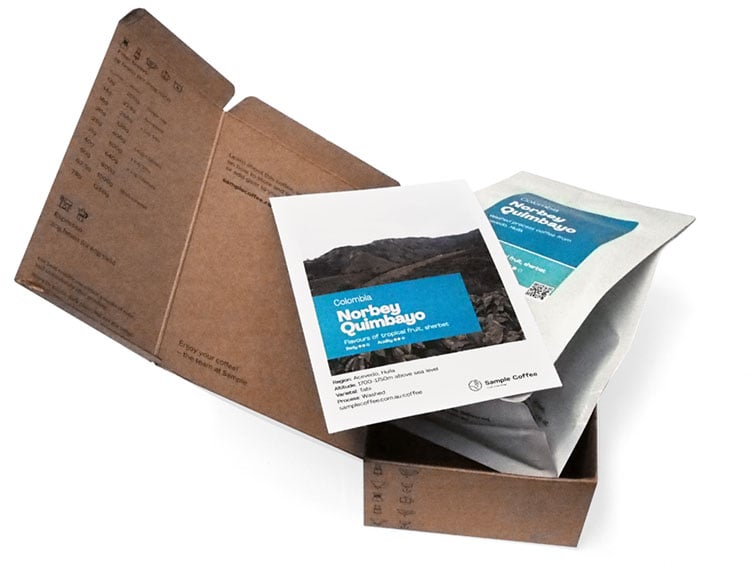Guatemala
Peña Blanca
You might have heard that great coffee harvests come from areas with diverse microclimates, and this coffee is a fine example.
Peña Blanca (White Rock) is a small section of Finca La Bolsa, a farm that we’ve featured several times recently. The farm is located near La Libertad, on some steep slopes in Guatemala’s Huehuetenango region.
María Elena Vides de Ovalle and her son Renardo Ovalle have decided to allow each combination of terrain, altitude and microclimate to speak for themselves by keeping each lot separate through all the processing stages so they can be roasted and tasted individually.
We’ve already featured several different lots of coffee from La Bolsa: Rincon at the end of 2016, Los Encuentros which we shared in 2015; and also La Huerta and La Libertad, which we’ve featured in our cafes previously. It’s great to see such variety and high quality coming from one farm, and it’s the result of the work María and Renardo put into managing the farm.
María Elena Vides de Ovalle and Renardo Ovalle (Snr)
Coffee was first planted at La Bolsa by Dr Jorge Vides in 1958, with María Elena Vides de Ovalle and her son Renardo Ovalle now owning and managing the farm.
Two rivers run across the property and provide the water for processing the coffee, hydroelectricity for the farm as well as supplying surplus water to the nearby La Mesilla municipality.
The view from the coffee plantation down to the wet mill and drying areas
In the photos from the farm, you can see the sort of terrain where the coffee is grown, and then picked by hand before being carried down to the wet mill for processing.
New plantations in the foreground, and again the wet mill and drying areas in the background.
Bourbon
This coffee is a combination of both the Caturra varietal and bourbon varietal of coffee, together they’re two of the most commonly seen varietals of arabica coffee.
Thought to originate on the Island of Bourbon (now Réunion Island) off Madagascar, bourbon grew out of mutations of Ethiopian and Yemeni arabica plants.
These plants were then further cultivated in Brazil, before they were transported back to East Africa. Bourbon is now most often associated with coffee crops in Rwanda and Burundi.
The video below tells the entertaining journey of how bourbon came to be, from James Hoffman’s talk at the 2014 UK Barista Championships.
If you haven’t already picked up a copy of his book The World Atlas of Coffee, trust us when we say it’s worth your time. James is managing director of the UK roaster Square Mile, a former world barista champion and also blogs and tweets his thoughts on coffee.
Sourcing and ingredients
100% Bourbon, Caturra coffee beans, provided by Silo and roasted by us on Gadigal land / Sydney.
Country grade: Unknown ?
Packaging
Bag: ABA Certified home compostable
Label: Recyclable
Valve (on bags larger than 250g): General waste
Coffee ordered online is shipped in a recyclable cardboard box
Brewing this coffee
We recommend brewing this coffee 15–49 days post-roast. If pre-ground, brew as soon as possible. Our advice on storing coffee.
1:3
dose:yield
ratio
To brew on espresso, we recommend using 20g of beans (dose) to get 60g of espresso out (yield), during 24-28 seconds.
1:16.7
beans:water
ratio
To brew in infusion/fed brewers (V60, Chemex) use a ratio of 1:16.7 ratio of beans:water.
1:14.3
beans:water
ratio
To brew in immersion brewers (plunger, AeroPress, Kalita, batch brewer) we recommend using a 1:14.3 ratio of beans:water
1:12
beans:water
ratio
To brew as cold brew we recommend using a 1:12 ratio of beans:water
Varietals
Bourbon varietal
A natural mutation of the Typica varietal, Bourbon is named after Reunion Island (then known as Il Bourbon) where the French cultivated the Typica plants which naturally mutated.
Caturra varietal
Caturra is a natural mutation of Bourbon that was originally discovered in Brazil in 1937, considered to be the first naturally occurring mutation ever discovered.
The location
Coffee from Guatemala
Guatemala’s production of coffee first grew in the 1860s on the back of a declining indigo trade, which had previously existed as it’s main export. Up until 2011 Guatemala was in the top 5 highest producing coffees nations in the world, before being overtaken by Honduras.
The Huehuetenango region of Guatemala
A non-volcanic region of Guatemala characterised by high altitude and predictable climate. Often considered to produce the highest quality coffee in Guatemala
Farm processes
Washed process
Machines are used to remove the flesh from the coffee cherry before being fermented in water, washed again, and finally sun dried. This process tends to result in more distinct, cleaner flavours.
1 brew note from subscribers
Guatemala Peña Blanca
 Paul’s V60
Paul’s V60
- 30g
- 450ml

Subscribe to a world of coffee
Discover a new single origin coffee from Sample every 1-5 weeks with no delivery fees.
No up-front purchase, and you can pause, cancel, or change plans at any time.
Available to order online this week:

Colombia Canta Ranas
Flavours of yellow peach, orange juice, raspberry, rosehip
Body Acidity
Washed Chiroso
May 2024 harvest
Roasted omni for filter and espresso
Colombia Canta Ranas online
Kenya Gathaithi
Flavours of burnt toffee, orange, cola
Body Acidity
Washed SL-28, SL-34, Ruiru 11, Batian
November 2023 harvest
Roasted omni for filter and espresso
Kenya Gathaithi online
Ethiopia Kecho Anderacha
Flavours of candied lemon, white peach, bergamot
Body Acidity
Washed Ethiopian Heirloom
November 2023 harvest
Roasted omni for filter and espresso
Ethiopia Kecho Anderacha online
Colombia La Serrania Decaf
Flavours of honey and blackberry
Body Acidity
Washed + EA Natural Decaf Caturra, Castillo, V.Colombia
Roasted omni for filter and espresso
Colombia La Serrania Decaf online